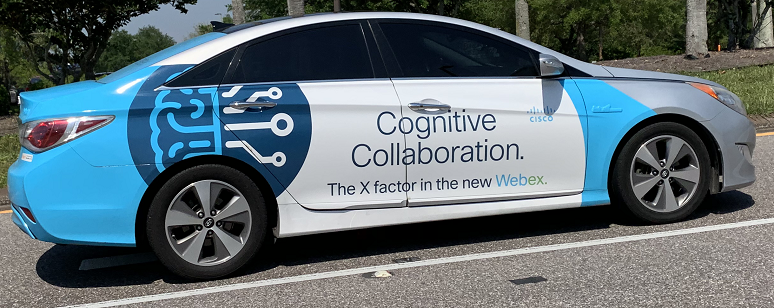As mentioned by others here on No Jitter, artificial intelligence (AI) was the hot topic at Enterprise Connect 2019. From Microsoft Graph to Amazon Alexa for Business to Google Dialogflow to Cisco Cognitive Collaboration, AI-infused products were promoted for their ability to improve our business collaboration and business operations. AI was so popular that even random drivers in Kissimmee, Fla., got into the act by promoting their favorite AI solutions with vehicle wraps, as shown below.
Nowhere was the topic of AI more prominent than in some of the Contact Center & Customer Experience sessions. I attended as many AI-related breakout sessions as possible and had numerous discussions about the key ideas that emerged from them. Here are some of the insights I learned throughout the week.
The Transformative Impacts of Artificial Intelligence on UC
In this tutorial, industry analyst Kevin Kieller, of enableUC, discussed AI technologies and how they are intersecting with and enhancing unified communications. I took away these key points:
- The importance of gathering and storing data. Data drives AI, which means you should begin capturing as much data as possible. You never know when it will be useful as a factor in a future AI project.
- Make sure the data you capture is normalized, or at least labeled. If you capture numbers, make sure the data reflects what the numbers represent, such as dollars or euros. Make sure the data is labeled insofar as possible.
- Don't rush down the path to AI if you don't need it. Applying AI without delivering results isn’t useful.
- AI is still in its infancy. Some of the interesting things in UC right now involve intelligent or automatic meetings joins, video background blur, counting participants in a meeting, note taking, automated action items, documenting decisions, and adjusting infrastructure in real time.
- In a multiparty meeting in which automated speech transcription is in use, speech-to-text works better if people join the meeting from home or a location outside of the conference room. If everyone is in the same room, distinguishing the different speakers is often difficult for the speech-to-text algorithm.
- AI comes with some legal implications and risks -- Kevin mentioned that 55 companies noted AI as a risk factor in their 2018 annual reports. One of the key risks is that AI algorithms may be flawed or biased in some way, meaning that they treat people differently in commercial situations that demand equal treatment under the law.
Legal Notification Required for Transcription?
Following Kevin’s session, I had an opportunity to speak with Martha Buyer, an attorney specializing in telecommunications law, in the speaker-ready room. Because speech-to-text and transcription are so important to communications generally, I pitched the following question to Martha, “Do we need to inform another party in a voice or video call if we are transcribing the audio, as opposed to just recording it?” Meaning, if we just transcribe the call but don’t record the audio or video, do we need to let the other person or people in the meeting know?
Natural language processing (NLP) tools work with text, and the implication is that as these AI tools become part of our normal toolkit, we’re likely to keep them “always on” in any type of meeting we participate in. Do we need to tell someone that the meeting is being transcribed even if is the audio isn’t being recorded? And, if we’re using a cloud-based service located in another state, does that impact our legal obligations?
Martha quickly found the legal code and responded as follows:
This is a great question and it’s been interesting finding the answer. Here is the federal statutory language... The magic word is intercept. It’s not even the “holding” of the information but rather its interception.
The state rules may be more specific, but I don’t think that you need to go much further than this to see that it’s the participation of a third party, regardless of how passive it is, that triggers the potential problem.
“It shall not be unlawful under this chapter for a person not acting under color of law to intercept a wire, oral, or electronic communication where such person is a party to the communication or where one of the parties to the communication has given prior consent to such interception unless such communication is intercepted to commit any criminal or tortious act in violation of the Constitution or laws of the U.S. or of any State.”
18 USC § 2511(2)(d)
Martha and I discussed these paragraphs and reached some conclusions. You can draw your own conclusions, or better yet, contact Martha directly for a great legal answer. The implication is that we may need to exercise some care as we use cloud-based transcription. The legal requirements may even vary from state to state. For example, in Utah, where I live, only one party needs to be aware that a voice communication is being recorded, but if I record it using a service that is in another state or the voice stream crosses state lines, does that make it so that both parties need notification? What are the rules for conversations that are automatically transcribed by an AI machine but that aren’t recorded? These are questions that will undoubtably come before a court somewhere. Per Kevin’s comment above about legal risks, AI and cloud-based services open new risk vectors that need exploring.
Click below to continue to next page: Automation Vs. AI-Assisted Humans, and more










